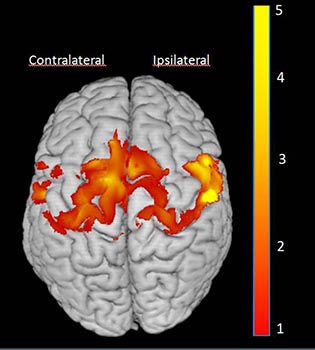Researchers at the University of Alabama at Birmingham (UAB) report that children with cerebral palsy who underwent Constraint Induced Movement therapy (CI therapy) saw a significant increase in grey matter volume in areas of the brain associated with movement. The findings, published online April 22, 2013 in Pediatrics, are the first to show that structural remodeling of the brain occurs during rehabilitation in a pediatric population.
 |
|
Cortical surface-rendered image of grey matter change. Grey matter increases displayed on a standard brain. Surface rendering was performed with a depth of 20 mm. Color bar values indicate t statistics ranging from 2.0 to 4.7. |
“It is well understood that CI therapy produces a re-wiring of the brain, leading to functional improvement in motor skills in children and adults who have experienced a brain injury,” said Edward Taub, Ph.D., the developer of CI therapy and a study co-author. “This study reinforces the idea that CI therapy also remodels the brain, producing a real, physical change in the brain.”
Grey matter is a component of the central nervous system, consisting primarily of neuronal cell bodies, glial cells and dendrites. The study examined ten children with cerebral palsy, between the ages of 2 and 7, who underwent a three week course of CI therapy. Changes in grey matter were assessed with a technique called voxel-based morphometry (VBM), performed on images acquired through magnetic resonance imaging.
“We saw increases in grey matter volume in the sensorimotor cortices on both sides of the brain and in the hippocampus,” said Chelsey Sterling, M.A., a graduate student in medical psychology and first author of the study. “These increases were accompanied by large improvements in spontaneous arm use in the home environment. Notably, increases in grey matter correlated with improvement in motor activity.”
Sterling says the significant correlation between increases in grey matter volume and magnitude of motor improvement raises the possibility of a causal relationship.
The researchers suggest the observed increase in grey matter could be due to one or more different processes, including an increase in synaptic density, the creation of new neurons or glial cells or the establishment of new blood vessels within the brain.
“An increase in grey matter is indicative that the brain is capable of supporting increased motor activity and function,” said Gitendra Uswatte, Ph.D., a study co-author. “Along with the improvements observed in the dexterity and everyday use of the arm that was the target of rehabilitation, this is a strong indication that a child with cerebral palsy can have substantial gains in motor function when provided with the correct stimulation.”
VBM analysis was performed three weeks prior to therapy, at the beginning of therapy and at the end of the three week therapy period. The authors say that no significant grey matter change was seen during the three weeks before treatment.
The children underwent intensive motor training for three hours each weekday for a three week period in which the child’s less-affected arm was continuously restrained in a long arm cast. Each child’s caregiver received a transfer package, which included steps to induce continuation of use of the more-affected arm at home. The MRI scans were performed at Children’s of Alabama.
Taub, a university professor in the Department of Psychology, developed the family of techniques called CI therapy. The therapy has been shown to be effective in improving the rehabilitation of movement after stroke and other neurological injuries in both children and adults.
“The motor improvement and changes in grey matter following CI therapy observed in this study are similar to those observed previously in adults,” said Taub. “It is further evidence that the brain has a remarkable capacity to heal itself when presented with an efficacious rehabilitation intervention such as CI therapy.”